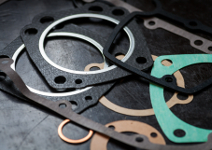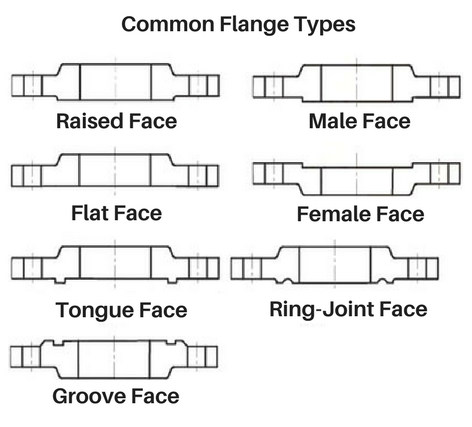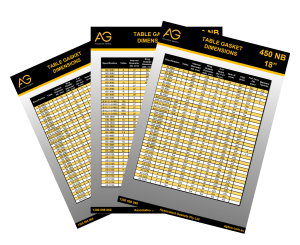When faced with the task of selecting a gasket for any particular application, the amount of styles, materials, sizes and options on the market can make the job extremely difficult for the inexperienced of us.
With gaskets being an essential component of all different types of equipment, vehicles and machinery the number of applications is literally endless and unfortunately there is no one-size-fits-all in the gasket game.
But before we get into how best to narrow down the options on the market and select the best, lets quickly touch on why selecting the correct gasket is important.

Why is selecting the correct gasket important?
Incorrect gasket selection will obviously lead to leaks and blow-outs which may happen straight away or the gasket may not last as long as it should or could and will require replacing more regularly than necessary.
In the worst instances leaking flange set-ups can also cause injury from contact with hot or toxic chemicals. Also, what most companies or businesses care about is their bottom line. Not using the correct gasket will cost you or your business money! So how can we try to mitigate this and select the correct gasket?



Learn every detail about your gaskets future environment.
The first step is to learn every detail about the gaskets future environment. This sounds like a daunting task, however there are really 3 main factors to assess and they are
Temperature; what upper and lower limits will the gasket be required to handle?
Pressure; how much pressure will be exerted on the gasket.
Chemical Compatability; you need to consider what type of media the gasket be sealing, how corrosive is it? What is the level of ozone present?
Evaluate the flange design and condition.
Once we know all we need to know about the environment that the gasket will live we need to know about where it will be housed which requires evaluating the flange design and it’s condition.
There are about 7 different types of “normal” flanges that are displayed in the graphic.
As you can see in the graphic they all have a different construction and as a result, not all types of gaskets will work for each however the flange design will help to narrow down the list of possible gasket option so we need to take note of it.
We then need to check the condition of the flange and in particular the sealing surface. Some things to look out for are the presence of corrosion. Badly, corroded flanges are going to make it extremely difficult to achieve a good seal and may limit the range of styles available for use.

Another detail to look out for are misaligned flanges. When flanges are misaligned flanges it is very difficult to achieve an even bolt load and eventually the gasket will fail even though it may not have been the gaskets fault.
Once we are happy with condition of the flange and we know what type of gasket options we are limited to because of a combination of the flange type and it’s future environmental factors, we are pretty much ready to select the style of gasket we will use.
Non-Metallic, Metallic or Semi-Metallic?
Now when selecting a gasket we have three different types that we can choose from and they are non-metallic which includes elastomeric materials (rubber’s) and compressed fibre, cellulose fibre, plastics and PTFE’s.
Mostly these are materials that seal under relatively low bolt loads and although they can handle a fair amount of pressure in some cases, we are not talking anywhere near as much as gaskets that are reinforced with metal like those in our next style, semi-metallic.

As the name suggests, semi-metallic gaskets contain a mix of metallic and non-metallic materials and the most popular type in this range is by far the spiral wound gasket (SWG). In this segment alone there are so many different material combinations that you could almost construct a gasket for any application you can think of.
The standard material combination for spirals utilizes steel reinforcing rings and winding combined with a graphite filler to seal, these spirals are mass produced and can be a very cost effective option for sealing in higher pressure environments. Other types of semi-metallic on the market are corrugated and metal jacketed gaskets which are both not as popular but have demonstrated superior performance in some individual applications and as such are still used.
Finally we have metallic gaskets. This category contains RTJ’s (Ring Type Joints) and Kammprofile gaskets. These are generally used for very high pressure applications and require a higher amount of bolt load to seal. They are often found in critical service applications such as oil and gas pipelines and refineries. Metallic gaskets are not cheap, but the applications that require them are generally not either.
Gasket Sizing: Standard or Custom?
These standards stipulate the size of the pipe, flange and therefore also the size of the gasket, how many holes it is to have, the size of the holes and location of the bolt circle (PCD). These gaskets are often known as “table gaskets” and sizing information for the most popular standards can be found by clicking this link.
At this point we have by now selected the type of gasket we are going to use and what it will be made from which means all that is left is to determine what size it needs to be. In most applications the size will be determined by the nominal bore of the pipe and flange used. These are usually manufactured to a certain standard which may vary because of the country the equipment was manufactured or a range of other factors. Some of the most common standards encountered are:
- ANSI (American National Standards Institute)
- ASME (American Society of Mechanical Engineers)
- DIN (German Institute for Standardization)
- BS (British Standard)

These standards stipulate the size of the pipe, flange and therefore also the size of the gasket, how many holes it is to have, the size of the holes and location of the bolt circle (PCD). These gaskets are often known as “table gaskets” and sizing information for the most popular standards can be found by clicking this link.
What can I do if I am still not sure I have selected the correct gasket?
Talk to a gasket design expert! This is very important. If you are unsure about any of the previous steps or simply don’t have enough information you should not hesitate to talk to a gasket design engineer.
In the sealing game there really is no substitute for experience and we have years and years of that here at AG. It’s not worth taking risks that may turn out to be extremely costly. If you need to get in contact, head over here to find details of your closest branch.
